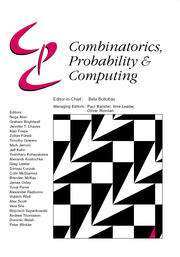Article contents
Local Resilience and Hamiltonicity Maker–Breaker Games in Random Regular Graphs
Published online by Cambridge University Press: 16 December 2010
Abstract
For an increasing monotone graph property  the local resilience of a graph G with respect to
the local resilience of a graph G with respect to  is the minimal r for which there exists a subgraph H ⊆ G with all degrees at most r, such that the removal of the edges of H from G creates a graph that does not possess
is the minimal r for which there exists a subgraph H ⊆ G with all degrees at most r, such that the removal of the edges of H from G creates a graph that does not possess  . This notion, which was implicitly studied for some ad hoc properties, was recently treated in a more systematic way in a paper by Sudakov and Vu. Most research conducted with respect to this distance notion focused on the binomial random graph model
. This notion, which was implicitly studied for some ad hoc properties, was recently treated in a more systematic way in a paper by Sudakov and Vu. Most research conducted with respect to this distance notion focused on the binomial random graph model  (n, p) and some families of pseudo-random graphs with respect to several graph properties, such as containing a perfect matching and being Hamiltonian, to name a few. In this paper we continue to explore the local resilience notion, but turn our attention to random and pseudo-random regular graphs of constant degree. We investigate the local resilience of the typical random d-regular graph with respect to edge and vertex connectivity, containing a perfect matching, and being Hamiltonian. In particular, we prove that for every positive ϵ and large enough values of d, with high probability, the local resilience of the random d-regular graph,
(n, p) and some families of pseudo-random graphs with respect to several graph properties, such as containing a perfect matching and being Hamiltonian, to name a few. In this paper we continue to explore the local resilience notion, but turn our attention to random and pseudo-random regular graphs of constant degree. We investigate the local resilience of the typical random d-regular graph with respect to edge and vertex connectivity, containing a perfect matching, and being Hamiltonian. In particular, we prove that for every positive ϵ and large enough values of d, with high probability, the local resilience of the random d-regular graph,  n, d, with respect to being Hamiltonian, is at least (1−ϵ)d/6. We also prove that for the binomial random graph model
n, d, with respect to being Hamiltonian, is at least (1−ϵ)d/6. We also prove that for the binomial random graph model  (n, p), for every positive ϵ > 0 and large enough values of K, if p >
(n, p), for every positive ϵ > 0 and large enough values of K, if p >  then, with high probability, the local resilience of
then, with high probability, the local resilience of  (n, p) with respect to being Hamiltonian is at least (1−ϵ)np/6. Finally, we apply similar techniques to positional games, and prove that if d is large enough then, with high probability, a typical random d-regular graph G is such that, in the unbiased Maker–Breaker game played on the edges of G, Maker has a winning strategy to create a Hamilton cycle.
(n, p) with respect to being Hamiltonian is at least (1−ϵ)np/6. Finally, we apply similar techniques to positional games, and prove that if d is large enough then, with high probability, a typical random d-regular graph G is such that, in the unbiased Maker–Breaker game played on the edges of G, Maker has a winning strategy to create a Hamilton cycle.
Information
- Type
- Paper
- Information
- Copyright
- Copyright © Cambridge University Press 2010
References
- 23
- Cited by

